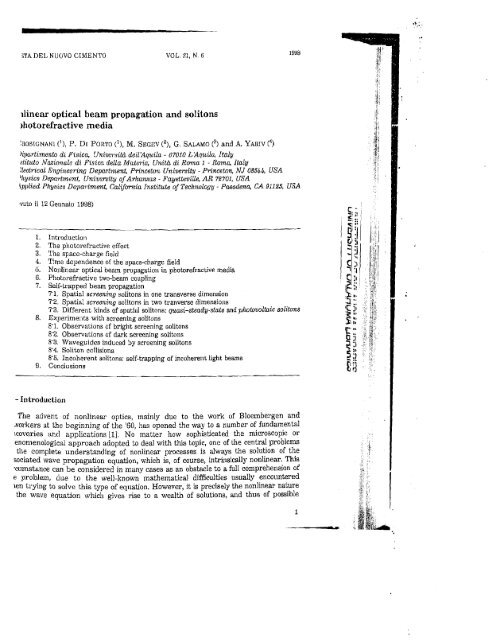Three - University of Arkansas Physics Department
Three - University of Arkansas Physics Department
Three - University of Arkansas Physics Department
Create successful ePaper yourself
Turn your PDF publications into a flip-book with our unique Google optimized e-Paper software.
3TA DEL NUOVO CIMENTO VOL. 21, N. 6<br />
ilinear optical beam propagation and solitons<br />
~hotorefractive media<br />
:ROSIGNANI (I), P. DI PORTO (I), M. SECEV G. SALAMO (9 and A. YARIV (4)<br />
)ipa.r-timento di Fisica, Univwsitd dell'Aqaila - 67020 L'Aquila, Italy<br />
slitz~to Nazion.ale di Rsicn della Maleria, Ur~itb di Rorna. 1 - Roma, Italy<br />
:lectvical Engitzeering Departmen6 Princeto71 <strong>University</strong> - Princeton, NJ 08544, USA<br />
'llysics <strong>Department</strong>, Uwivarsit~ <strong>of</strong> Arkansa,~ - J'ayettcville, Ah! 72701, USA<br />
Lpplied <strong>Physics</strong> Depal-tmmt, California Institute <strong>of</strong> Technology - Pasadena, CA 91125, USA<br />
vuto il 12 Gellnaio 1998)<br />
Introduction<br />
The photorefractive effect<br />
The space-charge field<br />
Time dependence <strong>of</strong> the space-chargc iield<br />
Nonlinear optical beam propagation in photorefractive media<br />
Photo~.efractive two-beam coupliag<br />
Self-trapped beam propagation<br />
7'1. Spatial screening solitons in one transverse dimensiou<br />
7'2. Spatial screening solitons in two tranverse climensions<br />
7'3. Different ltinds <strong>of</strong> spatial solitone: quusi-steady-state and photovoltai.c solitons<br />
Experiments with screeniag solitons<br />
8'1. Observations <strong>of</strong> bright screening solitons<br />
8'2. Observ'~,tions <strong>of</strong> dark screening solito~is<br />
8'3. Waveguides induced by screening solitons<br />
8'4. Soliton collisions<br />
8'5. Incoherent solitons: self-trapping <strong>of</strong> incoherent light beams<br />
Conclusions<br />
- Introduction<br />
I<br />
The advent <strong>of</strong> nonlinear optics, mainly due to the work <strong>of</strong> Bloembe~gen and<br />
~orkel-s at the beginning <strong>of</strong> the '60, has opened the way to a number. <strong>of</strong> fundainental<br />
;cove~ies and applications (11. No matter how sophisticated the microscopic or<br />
enomenological approach adopted to deal with this topic, one <strong>of</strong> the central problems<br />
the cornplete understanding <strong>of</strong> nonlinear processes is always the solution <strong>of</strong> the<br />
sociated wave propagation equation, which is, <strong>of</strong> course, intrinsically nonlinear. This<br />
.cumstance can be consiclered in many cases as an obstacle to a full comprehension <strong>of</strong><br />
e problem, due to the we]]-]cnown inathemstical difficulties usually encountered<br />
len trying to solve this type <strong>of</strong> ecluation. However, it is precisely the nonlinear. nature<br />
the wave equation which gives rise to a wealth <strong>of</strong> solutions, and thus <strong>of</strong> possible













